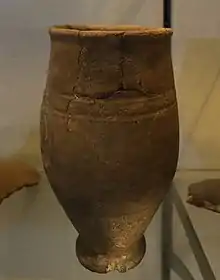Vectis ware
Vectis ware is the pottery produced on the Isle of Wight during the Roman period.[1]

Vectis ware is a hard, hand made pottery and most commonly very dark grey in colour due to Burnishing.[1] Three variants have been described.[2] By far the most common is the very dark grey variant the other two are a lighter grey variant and an oxidised variant.[2]
Production appears to have started prior to the Roman occupation and continued through most of it.[1][3] It doesn't appear to have been based at a single location but instead at a number of kiln sites along the north of the island.[1] The style was heavily influenced by Black-burnished ware with limited influence from North Gaulish styles.[1][3]
It was the most common form of pottery found at Brading Roman Villa.[3] It has also been found used as grave goods.[4]
References
- Tomalin, David J (1987). Roman Wight A Guide Catalogue to "The Island of Vectis, very near to Britannia". Isle of Wight County Council. pp. 30–31. ISBN 0906328373.
- Timby, Jane (2013). "Material Culture: pottery and fired clay". In Cunliffe, Barry (ed.). The Roman Villa at Brading, Isle of Wight: The Excavations of 2008-10. Oxford School or Archaeology. p. 165. ISBN 9781905905263.
- Timby, Jane (2013). "Material Culture: pottery and fired clay". In Cunliffe, Barry (ed.). The Roman Villa at Brading, Isle of Wight: The Excavations of 2008-10. Oxford School or Archaeology. p. 192. ISBN 9781905905263.
- Tait, Rachel; Tiley, Kate (2023). 100 Treasures and Curiosities from the Collection of Carisbrooke Castle Museum. Medina Publishing. p. 32. ISBN 9781911487975.